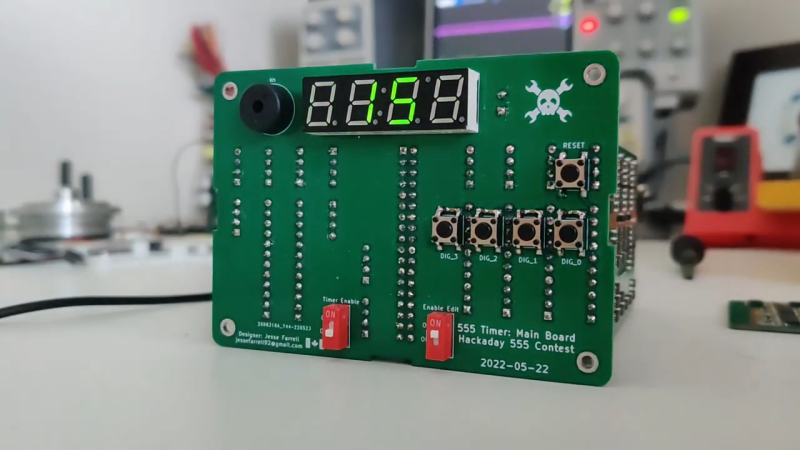When asked to whip up a simple egg timer, most of us could probably come up with a quick design based on the ubiquitous 555 timer. Add a couple of passives around the little eight-pin DIP, put an LED on it to show when time runs out, and maybe even add a pot for variable timing intervals if we’re feeling fancy. Heck, many of us could do it from memory.
So why exactly did [Jesse Farrell] manage to do essentially the same thing using a whopping 276 555s? Easy — because why not? Originally started as an entry in the latest iteration of our 555 Contest, [Jesse]’s goal was simple — build a functional timer with a digital display using nothing but 555s and the necessary passives. He ended up needing a few transistors and diodes to pull it off, but that’s a minor concession when you consider how many chips he replaced with 555s, including counters, decoders, multiplexers, and display drivers. All these chips were built up from basic logic gates, a latch, and a flip-flop, all made from one or more 555s, or variants like the 556 or 558.
As one can imagine, 276 chips take a lot of real estate, and it took eleven PCBs to complete the timer. A main board acts as the timer’s control panel as well as serving as a motherboard for ten other cards, each devoted to a different block of functions. It’s all neat and tidy, and very well-executed, which is in keeping with the excellent documentation [Jesse] produced. The whole thing is wonderfully, needlessly complex, and we couldn’t be more tickled to feature it.

















I get the 555 fetish and coolness factor.
But this is on the edge of resource waste and depletion. HaD Prize for environment conservation and this box, is a bit schizophrenic.Or I’m getting old?
What are you talking about? We’re not allowed to work on cool interesting projects anymore unless they’re strictly functional?
With current supply issues, maybe 555s were the only thing not on back-order? :D
They soon will be if everybody starts making these…
I mean, the effort is a brilliant one, and demonstrates an out-of-the-box application for the humble 555… definitely worth looking at for ideas… but I wouldn’t go replicating it verbatim. :-)
I doubt the production of this device factors much in the lifetime resource use and emissions of an individual. But it seems likely it will be a significant part of their electronics learning curve.
Might be better [educational value] per [resource] than many school books and toys.
More of an ecological bomb than a modern smartphone the average joe swaps each year? I feel like any fake outrage is misplaced here. Game theory itself predicts change can only happen if there is a benefit in it.
>”they will notice that their interests might at least sometimes be best served by getting the benefits from cooperation and not returning them”
Q: Why do green activity Y if another country does less of harmful thing X in place of myself?
Maybe some manufacturer should make an FPGA-like chip with hundreds of 555’s in it, configurable in different modes, and with configurable interconnects!
You have analog equivalents of an FPGA, but they don’t seem to find much traction.
Hah, this is absolutely mad and I love it.
I’d just use an 8-pin PIC or AVR.
Somebody show this guy to the door!
B^)
Too expensive! Just use a Padauk MCU a.k.a. the three cent MCU. :)
https://hackaday.io/page/6911-padauk-3-mcu-resources
I was waiting for a “could’ve used a micro” comment and I was not disappointed lol
But… How about 276 PIC’s, all programmed to like 555 timers?
Theres already 276 commenters on HaD that are programmed to like the 555, just use those.
Nah. FPGA.
Now that is dedication to the 555. For demo one could have just one down counting segment display, but here we have four! Why not? Nice job.
Should have used twice as many, and an extra 3 to link the two modules together!
I want a VHDL/Verilog to 555 translator
That literally exists:
https://hackaday.io/project/182915-555enabled-microprocessor
(Ok, I have removed NE555 logic from PCBflow in the meantime as it took up too many LOC)
https://hackaday.io/project/182915-555enabled-microprocessor
Some of this comes very close, but I am not sure how one goes about limiting the possible gates in a netlist, which the tools would then place in the form of 555 circuits. I think this project and associated tools are very cool, maybe not exactly practical but the abstraction is interesting.
https://hackaday.io/project/180839-vhdlverilog-to-discrete-logic-flow/log/199967-synthesis-and-technology-mapping
And this does VHDL/Verilog to Discrete Logic Flow, so that sounds like it is half way there :-)
it actually synthesized a VHDL file to a PCB:
https://github.com/cpldcpu/PCBFlow
(Ok, some manual intervention is needed, but it is pretty minimal)
i would avoid using a 555 as a timer because i don’t trust thermometers masquerading as timers
I really hate the fact that I understand how incredibly well done this commentary was and that a simple circuit involving thermocouplers and a 555 just popped into my head. XD
“thermometer masquerading as a timer.” Love it.
I would have used a pi to signal a esp to turn on a LED
Small fix for the documentation, and gates are NOT universal due to their inability to invert (and why inputs had to be bubbled upstream of the AND logic). NAND gates ARE universal in that regard.
My bad. Guess I should have proof read it one more time… thanks for pointing this out, I’ll correct the statement in the report. :)
My bad. Guess I should have proofread the document one more time… Thanks for the feedback, I’ve updated the statement in that section.
Beautiful and inventive project regardless *thumbs up*
This is art. Kudos. ❤️
It’s the perfect timer for the Midas World stories. https://en.wikipedia.org/wiki/Midas_World